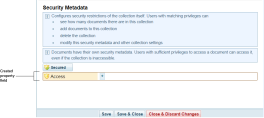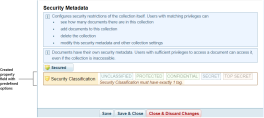Define Security Metadata Schema
The security metadata schema is used to create property fields which appear in the security metadata of collections A collection is a container for storing and organising ingested files and documents. Only the textual content is stored in collections, not the original files and documents. and networks A container that stores information in nodes and links. See Nodes and Links topic for more information.
Security metadata is assigned by entering values into these property fields.
Multiple property fields can be created in the security metadata schema.
Child element tags
|
Tag |
Description |
|
|---|---|---|
|
|
Property fields are created in the security model's security metadata schema with the The |
|
|
|
|
Accepts a value of
Selectable values are defined within additional |
|
|
|
Accepts any continuous text value. This is the value that gets referenced when security model rules are created. |
|
|
|
Accepts any continuous text value. This is the display name of the property field in the Sintelix user interface. |
|
|
|
Defines the minimum number of values a property field can accept. Normally set to zero or one. |
|
|
|
Defines the maximum number of values a property field can accept. If there is no limit, this should be to zero. |
|
|
|
Accepts a value of
|
|
|
|
|
Code examples
|
Task |
Code example and Sintelix UI output |
|---|---|
|
Create a Security Metadata property field that accepts unlimited values |
Sintelix UI output on Collections > Collection >Collection Configuration > Security Metadata pane: |
|
Create a Security Metadata property field that accepts a maximum of one value |
Sintelix UI output as shown above. |
|
Create a Security Metadata property field that must have exactly one value |
Sintelix UI output as shown above. |
|
Create a Security Metadata property field that must have one value from a selection of predefined options |
Sintelix UI output: |

